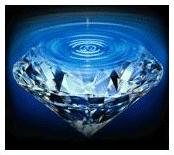| The Very Highest Quality Gemstone Information... |
| Cubic Zirconia |

|
|
|
CZ or Cubic Zirconia
Cubic zirconia, often abbreviated to CZ, is a synthetic stone used as a diamond simulant.
It is the oxide of the metallic element zirconium. Zirconium dioxide, known as baddeleyite, is found as a naturally occurring mineral, but with a different, monoclinic, crystalline structure. To induce it to crystallise in the cubic system, it is "doped" with small additions of other minerals, mainly yttrium or calcium. Cubic zirconia should not be confused with zircon, which is a rare naturally occurring gemstone.
Djevalite
It was first produced in 1977, and was originally marketed under the trade name of "Djevalite". It is difficult to produce because it requires very high temperatures, over 2,700 Celsius, to melt powdered zirconium and zirconium dioxide. Because of the high temperatures, it cannot be contained in a conventional crucible, but in a "skull" crucible where the crucible itself is formed from the melting material. It then needs to be carefully cooled and annealed. This produces a brilliant gem-like material which can be cut and polished in the same manner as natural gemstones.
Colours of CZ
By "doping" with different minerals, many different and attractive colours can be produced. The best known, and commonest is colourless, usually referred to as white.
Cerium oxides, CeO2, Ce2O3, produce red orange and yellow.
Copper, CuO, Iron, Fe2O3, Nickel, NiO, Praesiodymium, Pr2O3, and Titanium, TiO2, oxides all produce yellow amber and brown.
Erbium, Er2O3, Europium, Eu2O3, Holmium, Ho2O3, oxides produce pink.
Chromium, Cr2O3, Thulium, Tm2O3, Vanadium, V2O3, oxides produce olive green.
Cobalt, Co2O3, Manganese, MnO2, Neodymium, Nd2O3, oxides all produce lilac and violet.
Our company produced rings using many of these colours about 10 years ago, before they became "fashionable".
Other colours, including sapphire blue, and emerald green, can also be produced using larger amounts of stabiliser.
The Best Diamond Simulant
CZ's place as the most realistic diamond simulant ever produced has made it into one of the best selling "gemstones". Unfortunately, because it is inexpensive, many manufacturers have churned it out in cheap, and often nasty looking, jewellery, usually in 9 carat gold. Most consumers buying a CZ ring have bought it as a diamond substitute, and believe that it looks like a real diamond ring. A good quality diamond of reasonable size would never be mounted in 9 carat gold, or even 14 carat. Real diamond rings are invariably mounted in 18 carat gold, sometimes platinum. To create a ring or other article of jewellery which looks realistically like diamond jewellery, it is necessary to use a real diamond mount, and to have the stones properly set, rather than skimp on the quality of the setting work.
If CZ's are mounted in real, high quality, diamond mounts, then they are impossible to tell apart from diamonds using the naked eye, and without instruments.
CZ is Beautiful
Actually we believe that CZ possesses its own beauty and attraction, and our company have designed and created pieces of jewellery using CZ which were intended to exist as a jewel in their own right, and not meant to be mistaken for diamond. We still strongly believe that this is not only a logical and sensible, but also a creative view. It stems from our belief that jewellery is meant to give pleasure, and to be worn as an adornment. Please see our advice about jewellery as an investment.
Other Diamond Simulants
Other diamond simulants include glass, often known as "paste", white sapphire, both natural and synthetic, rock crystal (colourless quartz), spinel, both natural and synthetic, colourless sapphire, both natural and synthetic, YAG (yttrium aluminium garnet), strontium titanate, and the most recent moissanite.
One simple test for unmounted CZ is weight. Because of its high specific gravity, CZ is about 65% heavier than diamond.
Durability
CZ is quite hard, and retains it sparkle and polish well. It should not be allowed to rub against other gemstones, particularly diamond, because this will cause wear and scratching. This should be commonsense, and applies equally to all other gemstones. Wearing two diamond rings next to each other in such a way that the stones can come into contact with each other will cause wear and damage to both stones. Because diamond is many times harder than other gemstones, it will inflict greater wear and damage on other stones.
Cleaning
CZ jewellery can be cleaned using hot soapy water, or detergent, rinse thoroughly afterwards as detergents can cause dermatitis and allergic reactions. Enzyme cleaners should be avoided for the same reasons. Brushing with an old tooth brush to remove dirt and grease will also help. Cleaning agents containing chlorine may have a detrimental effect on low carat gold alloys, so are best avoided.
Technical Information
| Chemical Composition and Name | ZrO2 - Zirconium Dioxide |
| Hardness | 8.25 to 8.5 |
| Refractive Index | 2.15 |
| Specific Gravity | 5.65 - 5.95 |
| Crystalline System | Cubic |
| ...at the Lowest Possible Price |
|
32 - 36 Harrowside, Blackpool, Lancashire, FY4 1RJ, England. Telephone (44) - (0) 1253 - 343081 ; Fax 408058; E-mail: The URL for our main page is: https://24carat.co.uk | Chard(1964) Ltd |